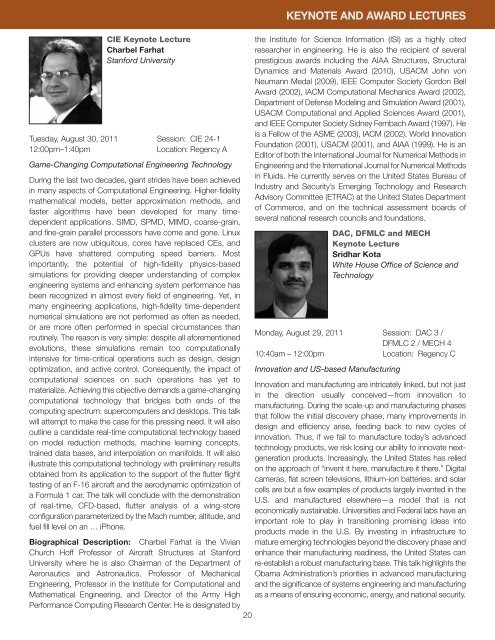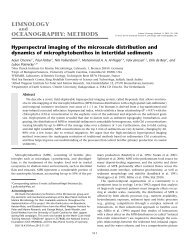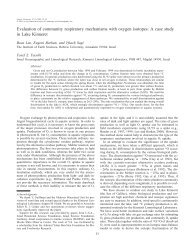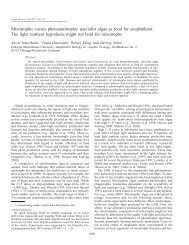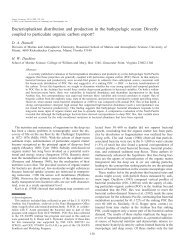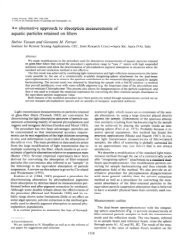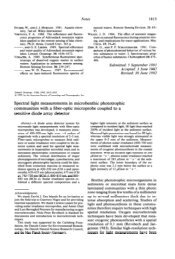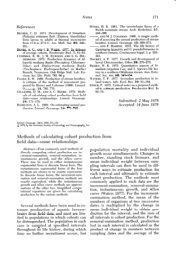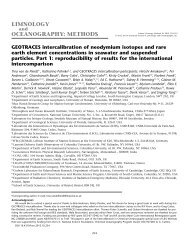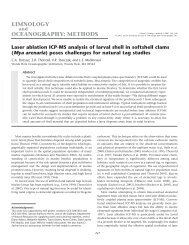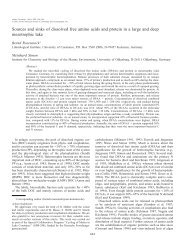Chia Yu Lin and Steven L. Manley. Bromoform production from - ASLO
Chia Yu Lin and Steven L. Manley. Bromoform production from - ASLO
Chia Yu Lin and Steven L. Manley. Bromoform production from - ASLO
Create successful ePaper yourself
Turn your PDF publications into a flip-book with our unique Google optimized e-Paper software.
CIE Keynote Lecture<br />
Charbel Farhat<br />
Stanford University<br />
Tuesday, August 30, 2011 Session: CIE 24-1<br />
12:00pm–1:40pm Location: Regency A<br />
Game-Changing Computational Engineering Technology<br />
During the last two decades, giant strides have been achieved<br />
in many aspects of Computational Engineering. Higher-fidelity<br />
mathematical models, better approximation methods, <strong>and</strong><br />
faster algorithms have been developed for many timedependent<br />
applications. SIMD, SPMD, MIMD, coarse-grain,<br />
<strong>and</strong> fine-grain parallel processors have come <strong>and</strong> gone. <strong>Lin</strong>ux<br />
clusters are now ubiquitous, cores have replaced CEs, <strong>and</strong><br />
GPUs have shattered computing speed barriers. Most<br />
importantly, the potential of high-fidelity physics-based<br />
simulations for providing deeper underst<strong>and</strong>ing of complex<br />
engineering systems <strong>and</strong> enhancing system performance has<br />
been recognized in almost every field of engineering. Yet, in<br />
many engineering applications, high-fidelity time-dependent<br />
numerical simulations are not performed as often as needed,<br />
or are more often performed in special circumstances than<br />
routinely. The reason is very simple: despite all aforementioned<br />
evolutions, these simulations remain too computationally<br />
intensive for time-critical operations such as design, design<br />
optimization, <strong>and</strong> active control. Consequently, the impact of<br />
computational sciences on such operations has yet to<br />
materialize. Achieving this objective dem<strong>and</strong>s a game-changing<br />
computational technology that bridges both ends of the<br />
computing spectrum: supercomputers <strong>and</strong> desktops. This talk<br />
will attempt to make the case for this pressing need. It will also<br />
outline a c<strong>and</strong>idate real-time computational technology based<br />
on model reduction methods, machine learning concepts,<br />
trained data bases, <strong>and</strong> interpolation on manifolds. It will also<br />
illustrate this computational technology with preliminary results<br />
obtained <strong>from</strong> its application to the support of the flutter flight<br />
testing of an F-16 aircraft <strong>and</strong> the aerodynamic optimization of<br />
a Formula 1 car. The talk will conclude with the demonstration<br />
of real-time, CFD-based, flutter analysis of a wing-store<br />
configuration parameterized by the Mach number, altitude, <strong>and</strong><br />
fuel fill level on an … iPhone.<br />
Biographical Description: Charbel Farhat is the Vivian<br />
Church Hoff Professor of Aircraft Structures at Stanford<br />
University where he is also Chairman of the Department of<br />
Aeronautics <strong>and</strong> Astronautics, Professor of Mechanical<br />
Engineering, Professor in the Institute for Computational <strong>and</strong><br />
Mathematical Engineering, <strong>and</strong> Director of the Army High<br />
Performance Computing Research Center. He is designated by<br />
20<br />
KEYNOTE AND AWARD LECTURES<br />
the Institute for Science Information (ISI) as a highly cited<br />
researcher in engineering. He is also the recipient of several<br />
prestigious awards including the AIAA Structures, Structural<br />
Dynamics <strong>and</strong> Materials Award (2010), USACM John von<br />
Neumann Medal (2009), IEEE Computer Society Gordon Bell<br />
Award (2002), IACM Computational Mechanics Award (2002),<br />
Department of Defense Modeling <strong>and</strong> Simulation Award (2001),<br />
USACM Computational <strong>and</strong> Applied Sciences Award (2001),<br />
<strong>and</strong> IEEE Computer Society Sidney Fernbach Award (1997). He<br />
is a Fellow of the ASME (2003), IACM (2002), World Innovation<br />
Foundation (2001), USACM (2001), <strong>and</strong> AIAA (1999). He is an<br />
Editor of both the International Journal for Numerical Methods in<br />
Engineering <strong>and</strong> the International Journal for Numerical Methods<br />
in Fluids. He currently serves on the United States Bureau of<br />
Industry <strong>and</strong> Security’s Emerging Technology <strong>and</strong> Research<br />
Advisory Committee (ETRAC) at the United States Department<br />
of Commerce, <strong>and</strong> on the technical assessment boards of<br />
several national research councils <strong>and</strong> foundations.<br />
DAC, DFMLC <strong>and</strong> MECH<br />
Keynote Lecture<br />
Sridhar Kota<br />
White House Office of Science <strong>and</strong><br />
Technology<br />
Monday, August 29, 2011 Session: DAC 3 /<br />
DFMLC 2 / MECH 4<br />
10:40am – 12:00pm Location: Regency C<br />
Innovation <strong>and</strong> US-based Manufacturing<br />
Innovation <strong>and</strong> manufacturing are intricately linked, but not just<br />
in the direction usually conceived—<strong>from</strong> innovation to<br />
manufacturing. During the scale-up <strong>and</strong> manufacturing phases<br />
that follow the initial discovery phase, many improvements in<br />
design <strong>and</strong> efficiency arise, feeding back to new cycles of<br />
innovation. Thus, if we fail to manufacture today’s advanced<br />
technology products, we risk losing our ability to innovate nextgeneration<br />
products. Increasingly, the United States has relied<br />
on the approach of “invent it here, manufacture it there.” Digital<br />
cameras, flat screen televisions, lithium-ion batteries, <strong>and</strong> solar<br />
cells are but a few examples of products largely invented in the<br />
U.S. <strong>and</strong> manufactured elsewhere—a model that is not<br />
economically sustainable. Universities <strong>and</strong> Federal labs have an<br />
important role to play in transitioning promising ideas into<br />
products made in the U.S. By investing in infrastructure to<br />
mature emerging technologies beyond the discovery phase <strong>and</strong><br />
enhance their manufacturing readiness, the United States can<br />
re-establish a robust manufacturing base. This talk highlights the<br />
Obama Administration’s priorities in advanced manufacturing<br />
<strong>and</strong> the significance of systems engineering <strong>and</strong> manufacturing<br />
as a means of ensuring economic, energy, <strong>and</strong> national security.


